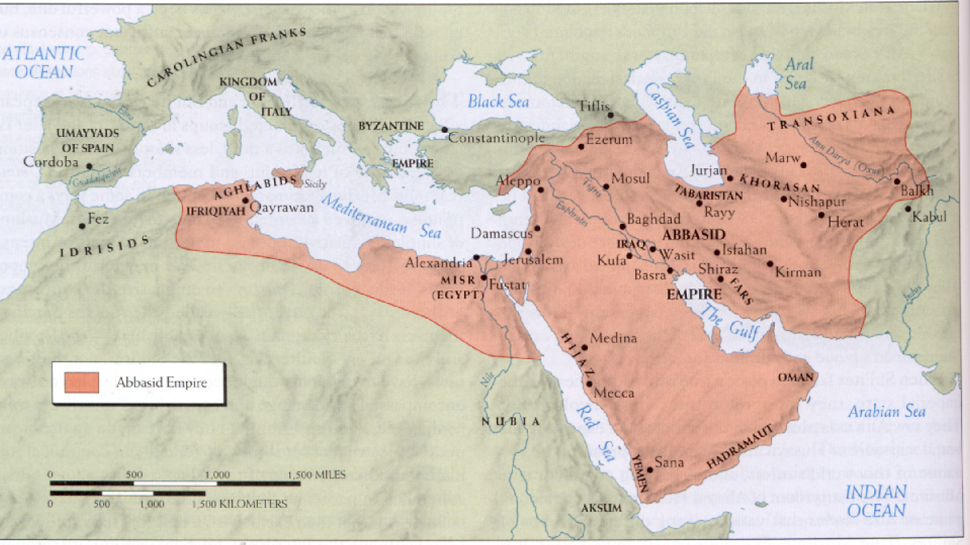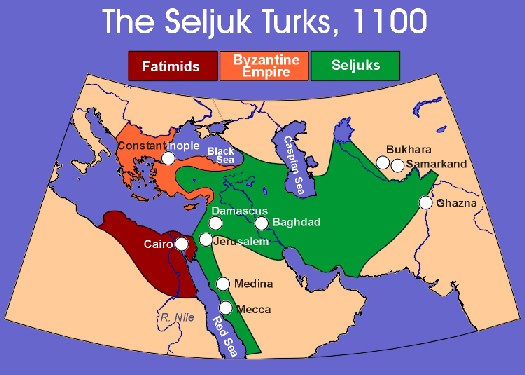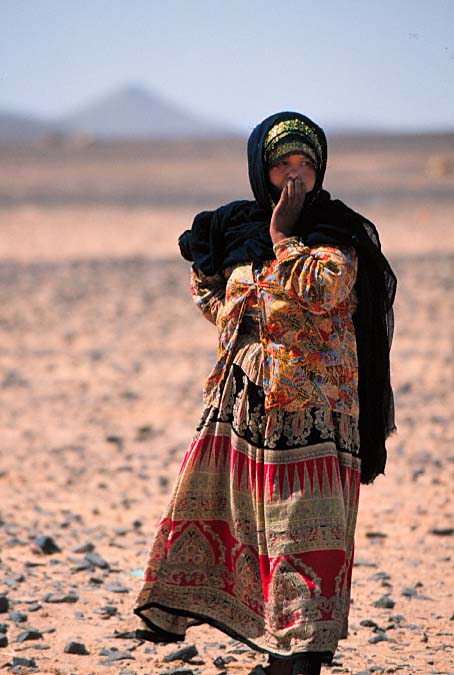I. The Rise and Fall of the Caliphate, 632-1258
The Islamic caliphate built on the conquests the Arabs carried out after Muhammad's death gave birth to a dynamic and creative religious society. By the late 800s, however, one piece after another of this huge realm broke away. While the idea of a caliphate remains a touchstone of Sunni belief in the unity of the umma, because Sunni Islam never gave one person the power to define true belief, expel heretics, and discipline clergy like the popes were given in the Christian faith.
A. The Islamic Conquests, 643-711
1. Arab Conquests Outside Arabia--began with the second caliph, Umar, who ruled between 634 to 644.
a. Syria (636)
b. Egypt (639-642)
c. Sasanid Empire (632-651)
d. Tunisia (661)
e. Iberian Peninsula (711)--except for the northern third of the peninsula, which remained a center of resistance to Muslim rule for the next seven centuries.
f. Sind (711)--the southern Indus Valley was also conquered by Arabs from Iraq.
2. Stability--this vast area remained largely under the control of Arabs for the next three centuries, until conquest began anew during the 11th century when India and Anatolia experienced invasions and large portions of sub-Saharan Africa was converted peacefully to Islam through trade contacts.
3. Reasons for conquest--although these Arab conquerors all shared the same Muslim faith, they did not fight for converts to this religion; they instead fought to obtain the booty of war. The second caliph, Umar, prohibited Arabs from assuming ownership of conquered territory, and insisted that soldiers had to remain in a military camp to be eligible for the regular pay and opportunities for the spoils of war. The million or so Arabs who over the generations took part in these conquests constituted a small, self-isolated minority living on the taxes paid by a vastly non-Arab and non-Muslim subject population. The Arabs had little incentive to encourage conversion, and there is little evidence of a coherent missionary effort to spread Islam during the conquest period.
B. The Umayyad and Early Abbasid Caliphates, 661-850
1. Arab realm--the Umayyad caliphs presided over an Arab realm, rather than a religious empire. Centered in Damascus, they Umayyad regime relied upon an army consisting almost entirely of Muslim Arabs; they retained Sasanid and Byzantine administrative practices, and gradually replaced non-Muslim secretaries and tax officials with Muslims, as well as introducing Arabic and the language of government.
2. Growing unrest--although converts to Islam in this period only made up about 10 percent of the indigenous population, they were still important because of the small number of Arab warriors--and these converts resented the Arab social domination. In addition, non-Syrian Arabs envied the Syrian domination of caliph affairs, pious Muslims were disappointed with the unpious behavior of the caliphs, and Shi'ites and Kharijites attacked the Umayyad family's legitimacy as the heirs of Muhammad.
3. Abbasid Revolution--in 750, in the region of Khurasan in what is today northeastern Iran, the last Umayyad caliph was overthrown. The Abbas family controlled the secret organization that coordinated the revolt, and utilized their kin connection with leading Shi'ites who were related to Ali, and in this way gained Shi'ite assistance to gain control. The Abbasid Caliphate remained in control of the region until 1258, when Mongol invaders killed the last of them in Baghdad.
a. With its roots among the semi-Persianized Arabs of the Khurasan, this new dynasty gradually adopted many of the ceremonies and customs of the Sasanid shah, and the government grew more complex in Baghdad.
b. With more non-Arab peoples converting to Islam, the ruling elite became more cosmopolitan, and this in turn promoted the growth of literature.
c. With the greater number of converts to Islam, discrimintation against non-Arab Muslims gradually faced.
C. Political Fragmentation, 850-1050
1. Abbasid Decline--caused by a variety of factors: limits of communication over such a vast area; lessening of the umma's solidarity, as the conversion of larger numbers of local populations lessened the threat against Islam. This then led local political elites to seek greater independence from the caliphate, to set up local principalities, and to siphon of a larger share of the tax revenue that previously went to Baghdad.
2. Mamluk Slave Soldiers--declining revenues, and the growing distrust of outlyings generals and troops, who were growing increasingly close to local elites, induced the caliphate to buy Turkic slaves called mamluks from Central Asia, and establish them as a standing army. The mamluk army proved to be extremely effective militarily, but also very costly--and prone to uprisising if not paid in a timely fashion.
3. Fall of the Abbasid Caliphate--in 945, after several attempts to save it proved fruitless, the Abbasid Caliphate fell to the Buyid family, from the Daylam region in northern Iran. The Buyids were Shi'ite, but because Shi'ite ideology had developed the idea that the last Iman had disappeared around 873, and would not reappear until the end of time, they were willing to keep the Abbasid caliph on the throne to keep the Sunni population in line.
4. Samanid Dynasty--this political fragmentation led to the rise of a number of smaller principalities, including the Samanid family, who established one of the more prosperous courts in Bukhara, a major city along the Silk Road. The Samanids patronized literature and learning, but the literature produced was in Persian written in Arabic letters.
5. African Muslims--Berber revolts against Arab rule led to the appearance after 740 let to the appearance of the city-states of Sijilmasa and Tahert on the northern fringe of the Sahara. The Kharijite (a second deviation from the Sunni/Shi'ite split) beliefs interfered with their east-west trade, and led them to begin to seek trading partners in the Sahara--where they found the Berber people. The earliest known sub-Saharan beneficiaries of this trade was the kingdom of Ghana, which was a major source of gold. It was one of the first lands outside the orbit of the caliphate to experience a gradual and peaceful conversion to Islam.
6. The Fatimid Caliphate--claimed to be be Shi'ite Imams descended from Ali (this claim is somewhate doubtful, however) established itself in Tunisia in 909. After consolidating its hold on northwest Africa, the Fatimids conquered Egypt in 969. Claiming the title of caliph in a direct challenge to the Abbasids, the Fatimids established their capitol in a town they called Cairo. The gold they were able to channel their way from West Africa made the Fatimids a major economic power in the Mediterranean.
7. Islamic Iberia--cut off from the rest of the Islamic world by the Straits of Gibraltar and, from 740, by the independent city-states of Morocco and Algeria, Umayyad Spain developed a distinctive Islamic culture that blended Roman, Germanic, and Jewish traditions with those of Arabs and Berbers. Although historians disagree on how quickly most of the Iberian population converted to Islam, it seems likely that the most rapid surge occured in the 10th century.
a. Muslims were responsible for developing cities in Iberia, particularly Cordoba, Seville, and Toledo, and for inspiring the development of the arts.
D. Assault from Within and Without, 1050-1258
1. Turks in the Middle East--The Turkish mamluks overthrew the remnant of the Abbasid Caliphate in 1030, when the Seljuk family established a Turkish Muslim state. Tughril Beg created a kingdom that stretched fro northern Afghanistan to Baghdad. The Seljuks later pressed on into Syria and Anatolia, administering a lethal blow to Byzantine power at the Battle of Manzikert, forcing the Byzantine army to retreat to Constantinople, from which they never emerged.
2. Economic Decline--under Turkish rule, the nomadic background of the Seljuks led them to neglect the infrastructure that had supported agriculture in the region; agriculture, as a not unsurprising result, went into decline--aided by global cooling which also affected raising crops.
3. Crusader Challenge--internecine feuding preoccupied the Seljuk family when the Christian Crusaders arrived in 1099. Although these Christians were able to establish principalities in Edessa, Antioch, Tripoli, and Jersalem, these cities quickly became mere pawn in the shifting pattern of politics already present.
a. Salah-al-Din (Saladin)--a Kurd who seized power at the death of his uncle, defeated the Fatimid Dynasty in Egypt and Syria, and in 1187 recaptured Jerusalem from the Europeans. Saladin's descendents defeated subsequent Crusades.
II. Islamic Civiliation
A. Law and Dogma--The Shari'a did not exist in Muhammad's time. It developed after his death, as those who knew him personally also died, and it no longer was possible to refer to someone who could related how Muhammad would respond to a certain situation
1. Sunna and Hadith--while some Muslims argued for the concept that the reasoned considerations of a mature man offered the best resolution of issued not covered by Q'ranic revelation, other aruded for the sunna, or tradition, of the Prophet as the best guide. To understand the sunna, they collected and studied thousands of reports, called hadith, which purported to convey the precise workd or deeds of Muhammad.
2. The Shari'a--Muslim scholars collected those hadith they determined were the most reliable into books (Sunnis into six books, Shi'ites into four) that over time gained authoritative status, which every Muslim ruler was expected to abide by and to enforce. In practice, this expectation was often not met, but it provided an important basis for an urban lifestyle that varied little from Morocco to India.
B. Converts and Cities
1. Impact of Conversion--conversion was easy--one simply stated in the presence of a Muslim "There is no God by God, and Muhammad is the Messenger of God." There was no priesthood established by Muhammad to guide the faithful; usually one had to live among Arabs to learn to read the Q'ran, and to learn how to behave as a Muslim should. Continuing to live in one home community as a Muslim was more difficult, because religious belief had by this time become the main component of social identity. Migration into the growing cities was a way to avoid this, and to take advantage of the economic opportunities that were present in these places where Arab tax revenues were flowing.
2. Urban growth--Islam was largely an urban phenomenon, and as it grew, so did cities.
3. Islam and Society--these growing urban centers fostered the development of agriculture in adjacent rural areas, as they grew a variety of crops to feed these cities--and trade developed between cities, aided by abundant coinage.
4. Technology and Science--Muslim scholars inherited much of the knowlege propagated by the Greeks and Romans. The writings of Aristotle were translated into Arabic, and Muslim doctors and astronomers developed skills far in advance of their European counterparts.
C. Women and Islam
1. Women's lives--women seldom traveled. In rural areas, they worked in the fields; in urban areas, they were restricted largely to their own households. Only slave women could be in the presence of unrelated men; while men could have up to four wives, and as many slave concubines as he wished, a woman was restricted to only one husband.
2. Women's legal status--despite these onerous restrictions, Muslim women were better off than their Christian or Jewish counterparts. They could inherit property, which remained theirs to keep or sell. Women could remarry if their husbands divorced them, and they could initiate divorce proceedings under some circumstances. They could also go on a haj
3. Homosexuality--because of the restrictions placed on women, homosexual relationships were usually tolerated, although not encouraged.
4. Slavery--Islam allowed slavery, but forbade Muslims from enslaving other Muslims or so-called People of the Bood--Christians and Jews--except those captured during war, which was the fate of many women caputred in army camps. A heriditary slave society did not develop, however, and the offspring of slave women and Muslim men were born free.
C. Recenterring Islam
1. Ulama--although this kept Islam from splintering as much as Christianity would in the following centuries, factional disputes also arose among various Ulama groups as to what constituted proper Islamic practice.
2. Madrasa--a result of this splintering was the establishment of religious colleges in a number of cities, the madrasa gave a place for scholars drawn to these urban settlements to teach what they had learned from their ulama group
3. Sufi brotherhoods--roughly analogous to the development of fraternal groups.











This comment has been removed by the author.
ReplyDeleteI find this to be a very pro-Islamic commentary that ignores,changes and contradicts many established historical facts. Islam was, is and will contnue to be a religion with violence,terrorism and conquest at its center. Muhammed himself only succeede in converting Mecca at the head of an army. Muhammed said "One muslim with a sword is worth ten preachers on rooftops". after muhammed Jihaad or holy war almost suceeded in conquering most of the civilized world including Europe, North Africa most of the middle east and the places we know today that are completley Muslim. Indeed the crusades of the Middle ages were fought over the possesion of Israel and more importantly, Jerusalem. Ottoman Turks who were also Muslim conquored Constantinople the last great city of the Roman Empire. these are all well established and documented facts known to even novices in history.
ReplyDeleteSeeker of the Truth: Your reasoning that "Islam was, is and will continue to be a religion with violence, terrorism and conquest at its center" (conquest at its center doesn't fit in my mind as to what you want to say, perhaps you meant to include those conquered areas to be included with the kalifate's central command)is highly misconceived interpretation of Islam. A religion doesn't spread on the strength of military might, it can only conquer the areas but can not conquer the hearts. If sword was the reason of spreading Islam, where do the Mongols fit, where are they now, where are the nations of Genghis Khan, Hilaku Khan. They had set on fire the whole city of Baghdad, the centre of Muslim world at that point in time. Islam still exists, those attackers are nowhere now.
DeleteThe author has tried to be as much neutral as the history allowed him to be, and I think he has succeeded in his remaining so. He has given a summarized and general chronological events with reasons why those events occured. I think it is an acceptable analysis for both sides of the world. Your calculation is based on what is happening these days, that facts are there and nobody can deny these facts, only your analysis is wrong because you are just describing the tip of glacier that is visible to naked eye. What is in depth require a deep study of history to know why it is happening.
Not very long back, a historical scientist Mr. Samuel Huntington had written a controverial sentence in his book "Islam has bloody borders". I had given a reply to this, kindly google "not the whole truth mr. huntington", it is first on first page. After reading this you might change your opinion. Or may be not, but you cannot deny the reasonings I have put forth.
Your Blog provides all my required things. This is a nice Blog. You explained here information about the thing that I was searching for. It helps me a lot. You are doing great. Thank you for providing me the useful information's. Visit: Biography of Muhammed
ReplyDeleteThat Islam was founded on violence is a bitter fact which nobody can change. Another fact is that Islam subsists of violence.
ReplyDeleteMohammed was able to convert only 50 people in first ten years, and many of these were his relatives. In medina he was more successful, but there he consolidated his position by assassinating his critics(an abhorrent thing for a founder of a religion). He murdered those who became disenchanted with his religion, and established the killing of apostates as a standard Islamic practice.
What kept Islam going is that Muslims are not allowed to know of other religions, preaching of other religions to a Muslim is at the risk of death. Converting out of Islam is punishable by death. Pious Muslims are authorized to carry out this killing of converts to other religions, where the government could not do the killing.
Jihad, that requirement to fight for Islam is one of the pillars of Islam. It was only of recent that some Islamic scholars included personal strife as part of Jihad and not all scholars accept this. So Islam was firmly established through violence,propagated through violence and maintained through violence.
It is not easy for any, who knows the life of Muhammad, knows the history of Islam, and the current Islamic affairs, to honestly say that Islam is a religion of peace. Until Islam allows freedom of worship, freedom of association, and freedom of conscience, there will always be wars and strife in Muslim lands. The apparent stability in Saudi Arabia, and Iran will not be long, because the human spirit will continually strive for freedom and liberty.
There many beautiful things in Islam are far more numerous than the violence and lack of freedom, but they are marred and overshadowed by the violence. The sooner the greater majority of Muslim, face the bitter truth about their religion, the better it will be for everyone, Muslims included.